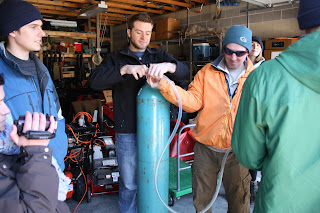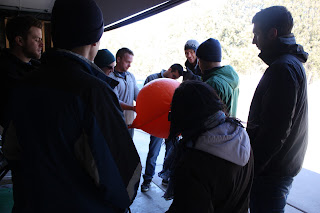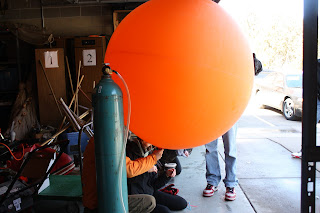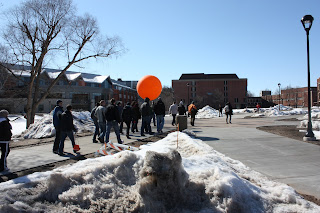Methodology: Due to the fact that there needed to be different tasks completed to make the launch happen, the class was split into different groups. Some were put in charge to fill the balloon, some needed to measure out 50 foot lengths on our balloon string, a videographer and photographer.
We measured out 50 foot sections of the string that would be holding the balloon. Our goal was to have the balloon 400 feet up into the air. Though, as you will later see, the wind did not allow the balloon to get that high.
 |
| Helium tank |
 |
| Starting to fill up balloon |
 |
| It's getting bigger! |
 |
| On our way to let the balloon go. |
We attached a GPS unit to the balloon to record a Tracklog of where the balloon had been.
Dr. Hupy is seen here attaching the GPS unit to the balloon. You can also see the little styrofoam container that housed the camera.
Of course, on the day of the launch, the weather was not cooperating much. It was about 30 degrees and very windy. The picture below does a good job showing how much of an angle the balloon was at in regards to where we were standing. Thus, dramatically lowering the altitude we hoped to get the balloon up to.
After the initial launch we decided to go back in and fill the balloon again, but with more helium, hoping that we could get more elevation despite the strong wind.
The second time we used both the camera and video camera.
Adding more helium to the balloon seemed to help. But, the wind was still strong and quite gusty at times. Regardless, we decided to take a walk around campus and even over the bridge that crosses the Chippewa River. When we got across the river we started to notice that the balloon seemed to be losing air. And then it all went down hill from there. The styrofoam box holding the camera actually fell from the balloon plummeting down into the icy cold Chippewa River. Luckily, prior to the second launch we decided not to attach the GPS because we did not wanted the added weight, otherwise I think we would have been down a GPS.
The video above shows not only the camera falling into the river, but it also shows how windy it was. The camera apparatus can be seen violently moving around.
Now, the whole point of sending a camera and a video camera 400 feet up into the air was to take photos and video of the surrounding landscape. The video is pretty straight forward.
But the photos needed to be mosiaced to try and come up with an image of the university grounds.
For those that are unfamiliar with what a mosiac is, it is an assemblage of smaller images to create one large image.
Mosiacing:
As seen in the video above, the wind really affected the quality of photos/video taken. A lot of the photos were of the horizon, not the ground. And the ones of the ground were not taken with the camera at a 90 degree angle to the ground. Here are some examples.
The photo above is not really the horizon, but it is pretty useless when trying to use it for mosiacing.
The beautiful Horizon.
With my limited experience in creating a mosiac, map creation in general and the distorted images, I tried my best to come up with a mosiac.
Nice huh?
Image of the area I was trying to Mosaic
Discussion: Once again this was a good experience. The weather was frustrating and luckily it only cost us a balloon and not a camera.
Conclusion: Well the weather really effected how everything turned out. The mosaicing was extremely difficult. Obviously it would be better to do it on a nice day, but with everybodies schedule it would be difficult to reschedule. But, this experience gave us ideas no how to do it differently next time.







No comments:
Post a Comment